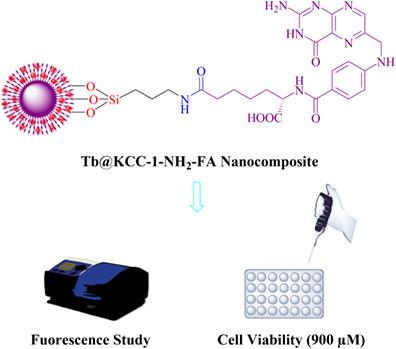当前位置:
X-MOL 学术
›
J. Mol. Recognit.
›
论文详情
Our official English website, www.x-mol.net, welcomes your feedback! (Note: you will need to create a separate account there.)
Synthesis of folic acid functionalized terbium-doped dendritic fibrous nano-silica and Interaction with HEK 293 normal, MDA breast cancer and HT 29 colon cancer cells.
Journal of Molecular Recognition ( IF 2.7 ) Pub Date : 2020-07-16 , DOI: 10.1002/jmr.2871 Sajjad Azizi 1 , Jafar Soleymani 1 , Nasrin Shadjou 2
Journal of Molecular Recognition ( IF 2.7 ) Pub Date : 2020-07-16 , DOI: 10.1002/jmr.2871 Sajjad Azizi 1 , Jafar Soleymani 1 , Nasrin Shadjou 2
Affiliation

|
A novel folic acid functionalized terbium‐doped dendritic fibrous nanoparticle (Tb@KCC‐1‐NH2‐FA) with high surface area was synthesized using a novel hydrothermal protocol. In the present work, we report the fluorescent Tb‐doted nanomaterial with emission wavelength at 497 nm which confirms the formation of Tb@KCC‐1‐NH2‐FA. Synthesized nanoparticles were investigated through transmission electron microscope, field emission scanning electron Microscopy, Fourier transform infrared spectra, Brunauer‐Emmett‐Teller, energy dispersive X‐ray, Zeta potential and particle size distribution values and AFM (Atomic force microscopy) techniques. Specially, our desired nanomaterial which has FA moieties on the surface of Tb@KCC‐1‐NH2‐FA where interact with folate receptor (FR) which there is on the surface of the various cancer cells. For this purpose, fluorescence microscopy images were used to prove the uptake of FA based nanomaterial with FR‐positive MDA breast cancer and HT 29 colon cancer cells. Also HEK 293 normal cells as FR‐negative cells verified the specificity of our desired nanomaterial toward the FR‐positive cells. The cytotoxicity survey of Tb@KCC‐1‐NH2‐FA was examined by MTT assays against MDA breast cancer, HT 29 colon cancer and HEK 293 Normal cell lines which confirmed their biocompatible nature with any significant cytotoxic effects even for concentration higher than 900 μg/mL which could be used as a non‐toxic catalyst or carrier in biological ambient. Hence, Tb@KCC‐1‐NH2‐FA were synthesized using green and hydrothermal method; the process was simple with good productivity and desired nanocomposite was non‐toxic.
中文翻译:

叶酸功能化掺铽树枝状纤维纳米二氧化硅的合成及其与 HEK 293 正常、MDA 乳腺癌和 HT 29 结肠癌细胞的相互作用。
使用新的水热方案合成了一种具有高表面积的新型叶酸功能化铽掺杂树枝状纤维纳米颗粒(Tb@KCC-1-NH 2 -FA)。在目前的工作中,我们报告了发射波长为 497 nm 的荧光 Tb 点纳米材料,这证实了 Tb@KCC-1-NH 2 的形成-F A。通过透射电子显微镜、场发射扫描电子显微镜、傅里叶变换红外光谱、Brunauer-Emmett-Teller、能量色散X射线、Zeta电位和粒度分布值以及AFM(原子力显微镜)技术研究合成的纳米粒子。特别是,我们想要的纳米材料在 Tb@KCC-1-NH2-FA 表面具有 FA 部分,与各种癌细胞表面的叶酸受体(FR)相互作用。为此,荧光显微镜图像用于证明基于 FA 的纳米材料对 FR 阳性 MDA 乳腺癌和 HT 29 结肠癌细胞的吸收。此外,作为 FR 阴性细胞的 HEK 293 正常细胞证实了我们所需的纳米材料对 FR 阳性细胞的特异性。Tb@KCC-1-NH的细胞毒性调查2- FA 已通过针对 MDA 乳腺癌、HT 29 结肠癌和 HEK 293 正常细胞系的 MTT 测定进行检查,证实了它们的生物相容性性质,即使浓度高于 900 μg/mL,也可用作非-生物环境中有毒的催化剂或载体。因此,采用绿色水热法合成了Tb@KCC-1-NH 2 -FA;该过程简单,生产率高,所需的纳米复合材料无毒。
更新日期:2020-07-16
中文翻译:

叶酸功能化掺铽树枝状纤维纳米二氧化硅的合成及其与 HEK 293 正常、MDA 乳腺癌和 HT 29 结肠癌细胞的相互作用。
使用新的水热方案合成了一种具有高表面积的新型叶酸功能化铽掺杂树枝状纤维纳米颗粒(Tb@KCC-1-NH 2 -FA)。在目前的工作中,我们报告了发射波长为 497 nm 的荧光 Tb 点纳米材料,这证实了 Tb@KCC-1-NH 2 的形成-F A。通过透射电子显微镜、场发射扫描电子显微镜、傅里叶变换红外光谱、Brunauer-Emmett-Teller、能量色散X射线、Zeta电位和粒度分布值以及AFM(原子力显微镜)技术研究合成的纳米粒子。特别是,我们想要的纳米材料在 Tb@KCC-1-NH2-FA 表面具有 FA 部分,与各种癌细胞表面的叶酸受体(FR)相互作用。为此,荧光显微镜图像用于证明基于 FA 的纳米材料对 FR 阳性 MDA 乳腺癌和 HT 29 结肠癌细胞的吸收。此外,作为 FR 阴性细胞的 HEK 293 正常细胞证实了我们所需的纳米材料对 FR 阳性细胞的特异性。Tb@KCC-1-NH的细胞毒性调查2- FA 已通过针对 MDA 乳腺癌、HT 29 结肠癌和 HEK 293 正常细胞系的 MTT 测定进行检查,证实了它们的生物相容性性质,即使浓度高于 900 μg/mL,也可用作非-生物环境中有毒的催化剂或载体。因此,采用绿色水热法合成了Tb@KCC-1-NH 2 -FA;该过程简单,生产率高,所需的纳米复合材料无毒。



























 京公网安备 11010802027423号
京公网安备 11010802027423号